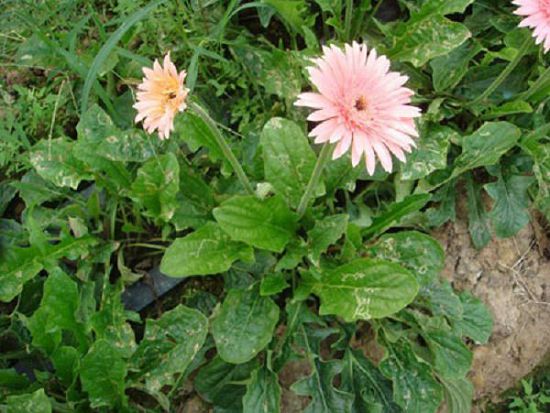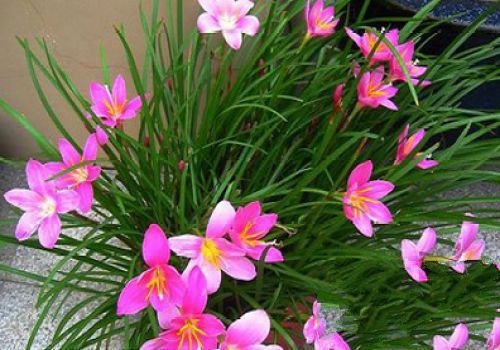Prevention and Control of Common Diseases of Family Flowers
At present, flowers are the main family greening plants for urban people, and all kinds of diseases are often encountered in the process of planting. If the prevention and control is not timely, it will lead to the growth of flowers. Here are the prevention and control methods of common flower diseases. Take a look at the right medicine.
(1) Root rot
Root rot is a plant disease caused by pathogens in the soil, usually characterized by withered leaves and slow growth, and the whole plant slowly turns yellow and loses its leaves.
The root rot is due to overwatering the plant, drowning the plant and causing the root system to rot.
When root rot occurs, take the plant out of the basin in time, throw away the old soil, cut off the rotten roots, pick the diseased branches and leaves, soak the potassium permanganate solution and replace the new soil into the basin and put it in a ventilated shade.
(2) powdery mildew
Powdery mildew is a common disease, and the probability of occurrence around it will be frequent, which is infected by fungi. Generally in the Meiyu season will be more active, at the beginning of the leaves appear white spots, and then slowly covered the whole leaf, until finally turned gray, pay attention to ventilation and light is the key, powdery mildew will spread slowly.
Found to deal with in time, found that powdery mildew infection, you can timely use a small teaspoon of detergent water to clean the leaves, and then seriously cut off the diseased leaves, timely spray chlorothalonil or methyl thiophanate solution.
(3) anthrax
Anthracnose is a very unpleasant disease, which usually occurs on the leaves of plants, showing that at first there are small spots of water stains on the leaves, and then the dots spread outward, turning into circles of brown spots, gradually spreading to the whole leaf to become brown and dry. The disease spot can form perforation, and the diseased leaf is easy to fall off.
Cutting off the diseased leaves and burning them in time at the initial stage of the disease can prevent expansion; during the onset of the disease, spraying 1000 times of 75% methyl thiophanate wettable powder and 75% chlorothalonil wettable powder, or carbon tetralin wettable powder or 50% carbon Fumei wettable powder. Once every 7 to 10 days, 3 to 4 times in a row, the control effect is better.
(4) Black mold
Also known as soot disease, generally caused by honeydew secreted by aphids, when there are such diseases and insect pests, it means that insect pests will occur. This kind of disease and insect pest will lead to the weakening of leaf photosynthesis, stomatal blockage and leaf shedding.
Prevention and treatment: the effective way to prevent and cure is to wipe the leaves with diluted soapy water.
(5) White silk disease
The whole plant of white silk disease is shown at the base of the root and stem, at first it appears white silk-like hyphae, then slowly affects the leaves, and finally decays and dies. White silk disease is generally produced in the environment of high temperature, high humidity and soil stagnant water, so we should pay attention to water control while paying attention to the overall environment.
Drug prevention and treatment: in the early stage of the disease, you can use silk to dilute 1000 times or Fengqian root protection 600,800 times, or to irrigate the roots of diseased plants with 1% copper sulfate solution or to spray with water spray with wettable powder.
(6) Fusarium wilt
Fusarium wilt is common in all kinds of fruits and vegetables, such as tomatoes, peppers, peas and melons. The symptom is that the top and lower leaves of the plant wither and recover slightly at night. After a period of time, the whole plant will wither.
What is more serious is that it affects the decay of flowers and fruits, which can seriously affect the condition of blooming and fruiting, first showing small spots on the flowers and fruits, and then slowly turning into black leathery patches as the fruit grows.
These are usually caused by random watering caused damage to the roots of plants, the calcium in the soil can not be absorbed by plants, resulting in a lack of water for plant growth, and is prone to disease in hot and dry environments.
As long as the plants are properly maintained, most of them can be avoided and spoiled, and the plants can be kept healthy. Do not water the leaves directly, keep them dry, and do not give plants too much water. This will help avoid infecting most of the diseases and insect pests. If diseases are found, cut off the diseased leaves and branches in time, and spray fungicides in time, such as chlorothalonil or methyl thiophanate solution.
There are six kinds of common diseases of flowers, you should pay attention to prevention in advance in the process of breeding, otherwise it will promote the occurrence of diseases, the above are detailed pest control methods, do not miss yo.
Related
- What if the leaves of potted flowers turn yellow?
- Florescence Control of several Flowers
- Anti-freezing technology and post-freezing nursing technology of flowers
- What is the classification of flowers? What are the common methods of flower classification?
- Prevention and control of alkali and acid damage of flowers in courtyard
- Technology of Anti-freezing and restoring growth of Flower seedlings in greenhouse and greenhouse
- How does flower fertilization not hurt the root? Fertilization technology of flowers
- Key points of disinfection in flower greenhouse
- Several pesticides that are banned or used cautiously in flowers
- How to fertilize the flowers that watch the leaves?



